 More Mirrorless Systems Guide 2024
More Mirrorless Systems Guide 2024
Overview
Mirrorless cameras each fit in a system which determines sensor-size and lens compatibility. For general information on mirrorless cameras, start with Step 1 of this mirrorless guide. In part 2 of Step 3 - this page - less established mirrorless systems are described and compared.
GenerallyWith the exception of Panasonic and Sigma that joined Leica. camera manufacturers launched their own mirrorless systems, or even two, and boot-strapped them with preferential compatibility with an existing system. This lets a mirrorless camera use DSLR lenses from the same manufacturer with few limitations via a mount-adapterExcept for Pentax K and Sony SLT systems which use a DSLR mount and Fuji whose discontinued DSLRs use a Nikon F-mount..
Leica L
Luxury brand Leica is famous for producing extremely high-quality optics. They maintain a line of mechanical M-mount manual lenses for their own digital rangefinder system. During the digital era, they focused mostly on producing Panasonic lenses, despite introducing a Leica Medium Format DSLR platform for a limited market.
Shortly after Sony launched the E-mount, Leica unveiled their own mirrorless platform. They designed the new Leica L-mount from the ground up to deliver the optimal balance between performance and size. This mount is wide enough for Full-Frame coverage but the camera was an APS-C mirrorless. Leica caters to a tiny segment of photographers that buy into the brand more than anything else. As a consequence, Leica cannot grow their systems quickly.

Eventually Panasonic decided to enter the Full-Frame market. Knowing the advantage of being early to market, having co-launched Micro Four-Thirds with Olympus, Panasonic found a short-cut by joining Leica. Sigma faced a similar dilemma with their aging S-mount for DSLRs and joined too. All three companies announced the L-Mount Alliance early last year with Panasonic launching two Full-Frame cameras and three lenses, while Sigma committed to produce 14 lenses within a year and work on several Full-Frame cameras too.
Leica System Mirrorless Cameras
Only Leica produces an APS-C camera with the L-mount. The Leica CL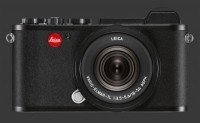
Leica CL is a rangerfinder-style mirrorless built around a 24 MP CMOS sensor with a hybrid shutter mechanism. It captures full-resolution images at 10 FPS and records 4K Ultra-HD video. The CL offers a large 0.5" EVF with 2.4 megapixels and 0.74X magnification plus dual control-dials but is not weatherproof, which is unusual at this price-point.
Panasonic joined Leica to enter the Full-Frame market and are extremely unlikely to produce APS-C models. In fact, most Panasonic Full-Frame Mirrorless Cameras are sizable models clearly designed to avoid competing with Micro Four-Thirds. Sigma already has APS-C and even APS-H mirrorless cameras. Joining the L-mount alliance, Sigma added their first full-frame mirrorless, the tiny Sigma fp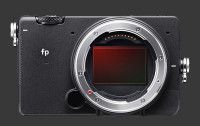
Sigma fp. This unique camera is minimally built around a 24 MP sensor. It has no mechanical shutter, no viewfinder and no built-in stabilization. It manages to pack in dual control-dials in its weatherproof body.
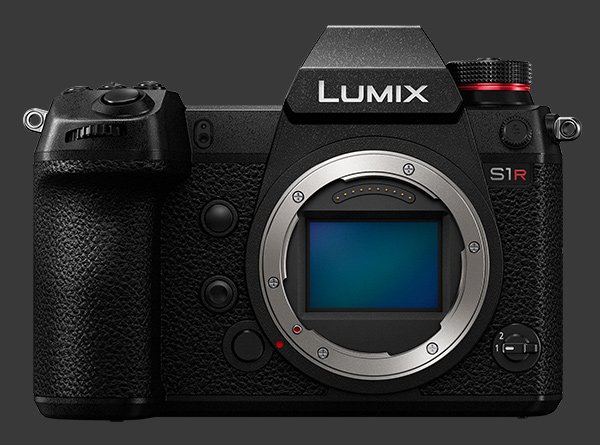
The twin Panasonic Lumix S1R
Panasonic Lumix S1R and S1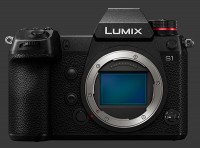
Panasonic Lumix DMC-S1 were announced simultaneously. These two Full-Frame Mirrorless Cameras feature a state-of-the-art built-in 5-axis image-stabilization system effective to 5.5-stops. Their 0.5" EVFs offer a spectacular 5.8 megapixels with a large 0.78X magnification and have an Eye-Start Sensor. Panasonic gave the S1R and S1 each professional-level controls with triple control-dials, a huge number of controls and a top status display. Both feel extremely sturdy with a weatherproof and freezeproof construction. The S1R captures 47 MP images while the S1 has 24 MP. With its larger pixels and smaller file size, the S1 offers an extra stops of sensitivity and can shoot 20X more frames per burst!
A video-oriented Panasonic Lumix S1H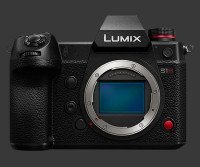
Panasonic Lumix S1H followed. This full-frame is based on the S1 with nearly identical specifications. The main differences are improved image-stabilization with 6-stops of efficiency, an anti-alias filter to reduce resolution slightly so that moire is less likely. The S1H allows 5.9K video capture for the very first time and can also record 5.4K, Cinema 4K or 4K Ultra-HD. All this makes the S1H larger and heavier than its siblings. Heading into the other directly, the S5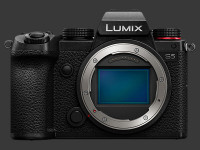
Panasonic Lumix S5 launched with similar specifications as the S1, albeit more compact.
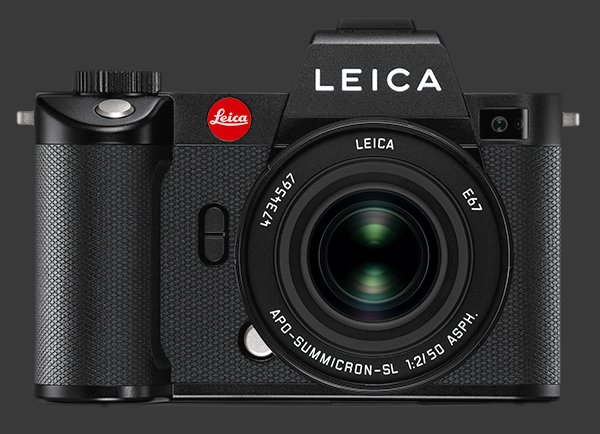
Leica caught up with a Full-Frame L-mount camera a few months ago. The new Leica SL2
Leica SL2 is built around the same 47 MP Full-Frame CMOS sensor as the S1R paired with a more powerfull processor. This gives it 2/3-stops extra sensitivity, faster electronic shutter-speeds, 10 FPS drive and 5K video capture. The SL2 features identically-specified image-stabilization, EVF and weather-resistance as the Panasonic. Its body features dual control-dials and is slightly lighter and a good smaller. Beinga Leica, it retails for almost double the price.
L-Mount Lenses
Exactly as intended, there are already a good number of Full-Frame L-mount lenses. which gives Panasonic and SIgma access to rectilinear lenses covering a 14-280mm focal-range within a year of announcing their Full-Frame Mirrorless Cameras! Leica also expanded its possibilities since there are now 3X more Full-Frame lenses before forming the alliance. The majority of those are weatherproof, while a handfull offer optical image stabilization. There are no specialty lenses yet.
Only 6 L-mount lenses for APS-C sensors exist. All made by Leica, since only they need them. Those cover a 11 to 135mm focal-range, although full-frame lenses are also compatible with the usual 1.5X crop-factor. The Leica TL Macro-Elmarit 60mm F/2.8 ASPH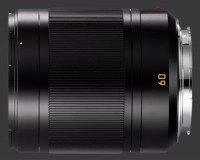
Leica TL Macro-Elmarit 60mm F/2.8 ASPH is the only L-mount Macro lens in existence.
Sony A
Shortly after launching their NEX system, Sony, who was being criticized for not having video-capable DSLRs yet, unveiled two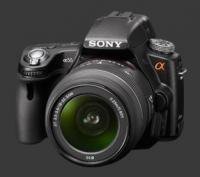
Sony Alpha SLT-A55 additions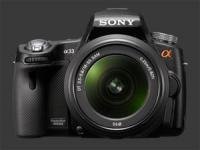
Sony Alpha SLT-A33 to the Alpha family. These cameras featured a semi-transparent mirror to divert light continuously to a Phase-Detect autofocus system and used a 1.5 megapixels EVF for eye-level shooting.

This design adds the ability to measure focus and meter during exposure and video capture which allows for high-speed shooting with continuous autofocus beyond what is currently available on most cameras. Movie capture also gets Phase-Detect AF which is much less bothersome than the usual Contrast-Detect AF.
Sony sees this as the evolution of DSLRs and so their marketing department calls them SLT, for Single Lens Translucent. Only the mirror is not translucentA translucent mirror would not allow for a sharp image. Instead a semi-transparent pellicle mirror is used.! After a while, Sony simply started calling these DSLR cameras while keeping SLT as part of the model-name. Unlike other mirrorless systems, Sony's SLT cameras do not offer a saving in size since they are comparable in size to specified DSLRs.
Sony A Mirrorless Cameras
Sony SLT cameras use the Alpha mount acquired from Konica-Minolta. This mount supports a Full-Frame imaging circle even though Konica-Minolta only used it with APS-C sensors since going digital. Sony offers SLT cameras with both sensor sizes.
Konica-Minolta invented sensor-shift image-stabilization and Sony kept using it on all SLT cameras. Given that this mechanism works with all lenses, including legacy ones, it is unsurprising that most other manufacturers have adopted this breakthrough.
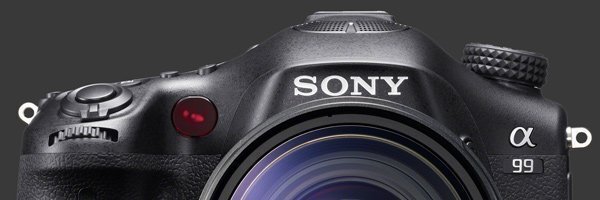
The lineup of SLT cameras has 3 series which Sony maintains with a single model on each:
- The flagship Sony Alpha A99 II
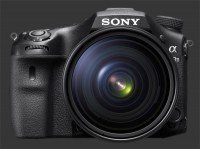
Sony Alpha A99 II is based around a high-resolution 42 megapixels Full-Frame BSI-CMOS sensor mounted on a 5-axis image-stabilization system effective to 4.5-stops. Its weatherproof body offers dual controls dials and a sizable 0.5" EVF with 2.4 MP and 0.78X magnification. - The SLT-A77 II
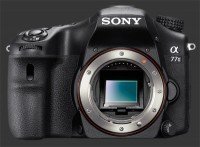
Sony Alpha A77 II mid-range offering also features dual control-dial in a weather-sealed body. This one maintains the simple 2-axis sensor-shift system invented by Konica-Minolta. - A single entry-level model offers 2-axis stabilization and dual control-dials in a smaller and lighter body. The EVF is less sharp at 1.4 MP and quite small with a 0.57X magnification.
Sony has implemented an Exposure-Priority Live-View on all their SLT cameras which offer a large LCD and high-resolution EVF, with up to 2.4 MP. An Eye-Start Sensor, also inherited from Konica-Minolta, automatically switches the between the EVF and LCD and is a pleasure to have.
A-Mount Lenses
Autofocus was invented by Minolta and implemented for the first time on the A-mount. Given that these cameras directly use the same mount, Sony SLT cameras accept a huge variety of lenses from Sony, Konica-Minolta and most third-party manufacturers. Sony A-mount lenses cover a 11 to 500mm focal-range. Additional coverage down to 8mm rectilinear or 4.5mm fisheye and up to 600mm is available from other brands.
There are lenses currently in production for most purposes. This includes constant-aperture zooms, bright primes, ultra-zooms, super-telephoto lenses and a number of high-quality autofocus lenses by Zeiss.
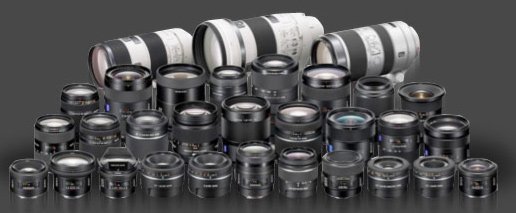
Nikon Z
As the digital camera market shifts towards the high-end, Nikon faces more competition than ever. While their DSLRs are consistently among the best, many enthusiasts and professionals are switching to mirrorless for modern advantages they offer. Almost 10 years ago, Nikon took it chances with their unique Nikon 1 system that is built around a 1" High-Speed CMOS sensor with built-in Phase-Detect AF. That platform was designed to avoid competing with any DSLR but it could not compete with other mirrorless systems either.
Nikon then launched an all-new Nikon Z system for mirrorless digital cameras. This plaform is built around a correspondingly named Z-mount that has the largest diameter and shortest flange-distance of any Full-Frame mount. The wide throat and allows lenses to be designed with much wider maximum aperture while maintaining high image-quality across the entire sensor-area.
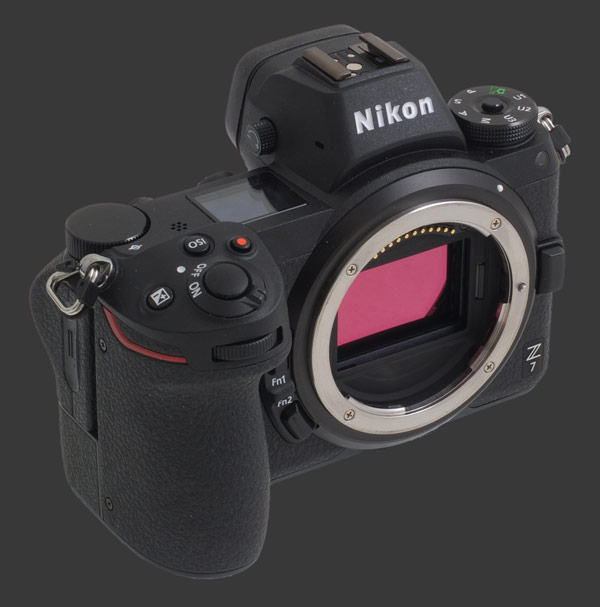
Nikon Z Mirrorless Cameras
As the second youngest mirrorless platform, there are just a handful of Nikon Z cameras. The platform launch saw the announcement of two externally identical models which differed only in their sensors. Both were Full-Frame mirrorless cameras with a built-in 5-axis image-stabilization system effective to 5-stops with native Z-mount lenses and on-sensor Phase-Detect autofocus. They features an ultra-high resoltuion 3.7 MP 0.5" EVF with an extra-large 0.8X magnification and an Eye-Start Sensor in a weaherproof body with dual control-dials
The Nikon Z7 reviewed here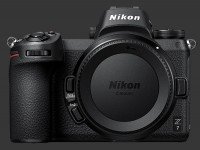
Nikon Z7 is built around a 46 megapixels Full-Frame CMOS sensor with an expanded ISO 32-102,400 range and 493-Point AF system. At full-resolution, the Z7 can shoot continuously at 9 FPS. The Nikon Z6 reviewed here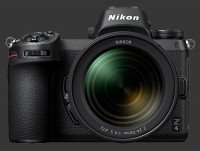
Nikon Z6 instead offers a 24 MP sensor with expanded ISO 50-204,800 range and a 273-Point AF system. Given its images are smaller, the Z6 can shooting at 12 FPS for longer. The most significant difference though is that the Z6 is one of the most affordable Full-Frame cameras on the market. Nikon followed both models with revised versions that add dual-memory-card slots: Z7 II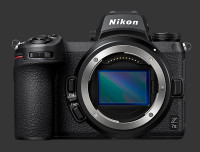
Nikon Z7 II and Z6 II
Nikon Z6 II
In late 2019, Nikon unexpectedly launched an APS-C mirrorless with the same Z-mount. While this new camera follows a similar physical design, the Nikon Z50
Nikon Z50 is quite different. Its 20 megapixels CMOS sensor offers the same ISO range as the Z6 yet with a 209-Point Phase-Detect AF system. Crucially though, the Z50 lacks built-in image-stabilization and its body is not weatherproof. It features a mid-size 2.4 MP 0.39" EVF with 0.68X magnification and relies on common SDXC cards rather than XQD like its full-frame siblings.
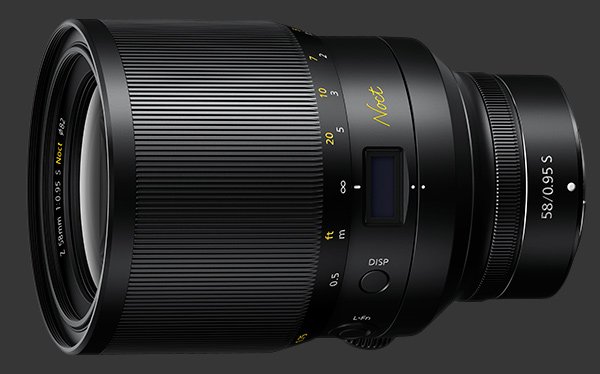
Z-Mount Lenses
Nikon is building up their lineup of Z-mount lenses. The wide-diameter of the mount makes it possible to create some extremely bright lenses and the Nikkor Z 58mm F/0.95 S Noct
Nikkor Z 58mm F/0.95 S Noct was launched to show it. This is the brightest lens currently available by any camera manufacturer.
Most of the lineup is geared to leverage the size-advantage of optics designed for mirrorless cameras. There are a good number of F/4 zoom lenses and F/1.8 primes. All Z-mount Full-Frame lenses together cover a 14-200mm focal-range with rectilinear lenses. These are all weatherproof. Stabilization is not needed on any of these lenses because both the Z7 and Z6 have IBIS. However, the Nikkor Z 70-200mm F/2.8S VR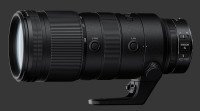
Nikkor Z 70-200mm F/2.8S VR has VR to make it usable on APS-C cameras. Unfortunately for the Z50, this leaves all other full-frame lenses unstabilized.
When the Z50 launched, there were no APS-C coverage only lenses available for Z-mount. Full-frame lenses can be mounted but they are larger and heavier than needed for a 1.5X crop. Nikon made 2 APS-C only lenses. They cover a 16-250mm focal-range with very dim variable aperture zooms.. Both these lenses are stabilized because the Z50 body is not and neither lens is weatherpoof, also because the body is not.
Third-party manufacturers are starting to make Z-mount lenses. All their lenses so far are fully manual lenses designed for Full-Frame cameras. They add rectinlinear coverage down to 10mm and ultra-macro lenses. Nikon does not offer native macro or specialty for their own system but they sell a F-to-Z adapter that supports pretty much all Nikkor AF-S lenses which is a huge lineup.
Fujifilm GFX
Fujifilm joined the Digital Medium Format race with an all-new GFX system. Inspired by their success with the X-system, their initial GFX 50S reviewed here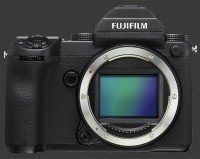
Fujifilm GFX 50S sports a similar hybrid design blending analog and digital controls into a body the size of a DSLR, yet with a larger 0.8X-crop sensor. Like traditional Medium Format cameras, the GFX system uses a 4:3 aspect-ratio. The larger sensor area, similar to other Digital Medium Format cameras provides exceptional image quality with incredible dynamic-range and low image-noise.
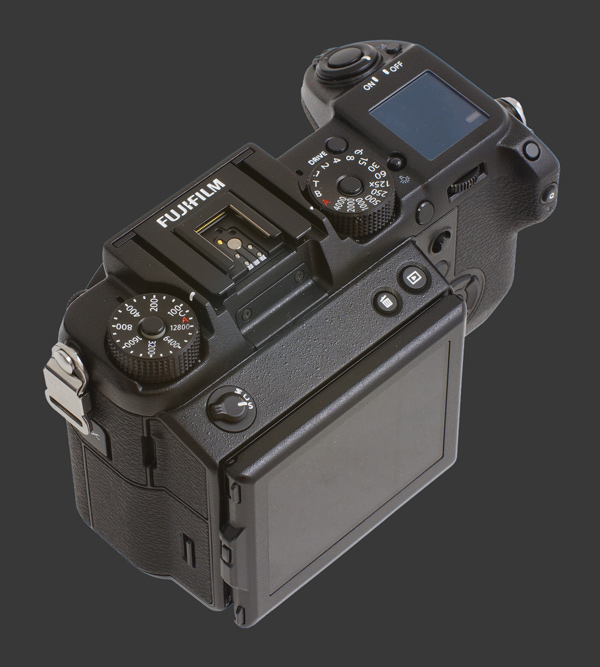
Fujifilm Medium Format Digital Cameras
Regardless of the platform, Medium Format Cameras are professional gear. These are expensive cameras that require pricey lenses which are quite large and heavy. Fujifilm made all their GFX-series to high-standards demanded by professional photographers. Every camera in the lineup offers dual control-dials in a weatherproof and freezeproof body. There are now 3 models in the lineup:
- The original GFX-50S set a high bar with its ultra-high resolution 50 megapixels CMOS sensor in a highly modular design. The camera uses a detachable viewfinder that can be mounted directly or on a unique tilt-adapter for extraordinary framing flexibility. The Optional EVF launched with the GFX-50S offered an extremely sharp 3.7 megapixels with a huge 0.85X magnification.
- A GFX 50R reviewed here
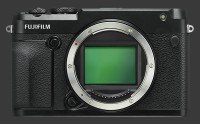
Fujifilm GFX 50R followed shortly after providing the same sensor and processor in an all-in-one form-factor. This made the camera more compact and featured a fixed 0.5" EVF with 3.7 MP and a large 0.77X coverage. - The enormous GFX 100
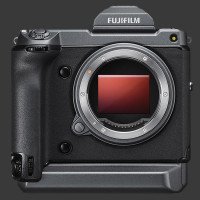
Fujifilm GFX 100 is an entirely new Medium-Format Digital Camera built around the same G-mount. Its sensor captures a class-leading 100 megapixels with a hybrid shutter and built-in 425-Point Phase-Detect AF. It is the only stabilized camera with a sensor larger than full-frame, featuring a 5-axis image-stabilization system effective to 5.5 stops. A new detachable 0.5" EVF unit with a class-leading 5.8 MP and 0.85X coverage launched with the GFX-100. - Technology advancements allowed Fujifilm to create a another 102 megapixels Medium Format camera and make it the size of a professional DSLR while maintaining nearly every feature of the GFX 100. The flagship Fujifilm GFX 100S
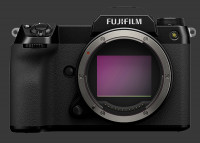
Fujifilm GFX 100S even offers improved image-stabilization with 6-stops of efficiency and only gives in by featuring a smaller 0.5" EVF with 3.7 MP and 0.77X magnification.
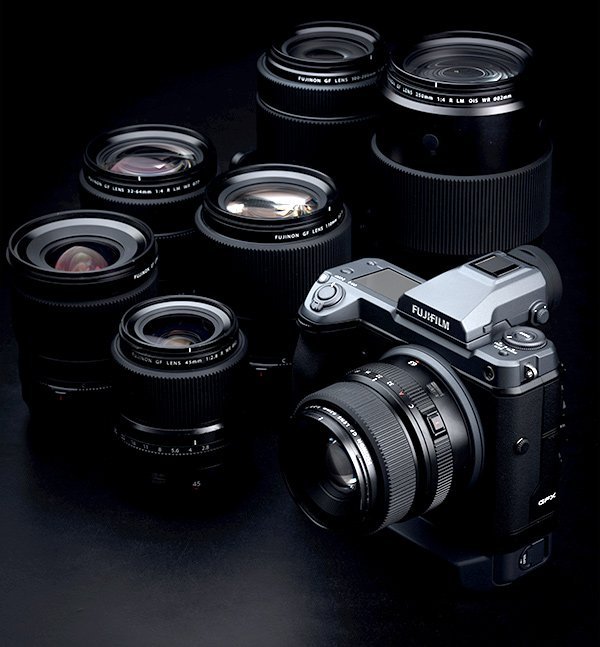
G-Mount Lenses
Along with their first Medium Format mirrorless, Fujifilm introduced a new all-electronic G-mount. The lineup has grown to 10 lenses barely 3 years after the launch. There are Fujifilm lenses for G-mount covering a 23-250mm focal-range now. The 0.8X FLM makes this equivalent to 18-200mm on a full-frame which is fairly good coverage.
All G-mount lenses produced by Fujifilm are designed to transmit at least 100 MP of resolutions. The entire lineup is weatherproof and freezeproof and the four longest lenses are stabilized. There are very few third-party lenses, although none are weatherproof, none are stabilized and none support autofocus.
Hasselblad XCD
Hasselblad introduced a Digital Medium Format mirrorless system around the same time as Fujifilm did. This platform also features a 0.8X crop-factor with 4:3 aspect-ratio. The new Hasselblad XCD system uses its own new all-electronic XCD lens-mount.
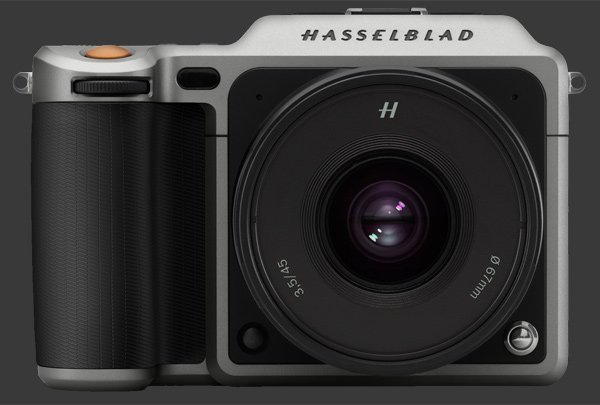
Hasselblad XCD Cameras
Two relatively compact models were launched, the original X1D 50C
Hasselblad X1D-50c and a X1D II 50C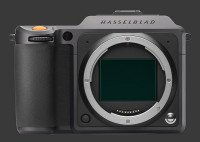
Hasselblad X1D II 50C refresh. Both are built around a 50 MP Medium Format CMOS sensor, likely to be the same as in the Fujifilm GFX-50S. Uniquely, this camera does not feature a shutter mechanism. Instead, they rely on lenses having a built-in shutter which offers the advantage of high sync-speed. However, legacy lenses cannot be adapted to this system since they have no shutter which would make exposure impossible.
Hasselblad created its own interface and style of ergonomics to optimize handling of such a small mirrorless camera, despite having a Medium Format sensor. There are still dual control-dials, a traditional mode-dial and a large 2.4 megapixels EVF with 100% coverage and an Eye-Start sensor.
XCD Lenses
Hasselblad has been keeping closely behind Fujifilm with now 9 XCD-Mount lenses, covering the 21-135mm focal-range. Only one of those is a zoom, while most others are relatively light prime lenses with mid-range maximum apertures. These cameras and lenses make the Hasselblad XCD system significantly lighter than GFX. Every XCD-mount lens is made by Hasselblad themselves. Requiring a leaf-shutter makes it unlikely that many third-party will produce compatible lenses.
Canon RF
Years after launching a mirrorless platform that failed to get much traction and not putting many resources behind it, Canon decided to try again with a new mount designed for maximum image-quality using a Full-Frame sensor. This time, the new platform would be redesigned from the ground up without compatibility to their APS-C mirrorless system, although it could support Canon EF lenses for Full-Frame DSLRs via an adapter.
The Canon RF platform is built around a completely new RF-mount. This new mount features a large diameter and very short flange distance to allow optics placement really close to the sensor. A new high-speed communication protocol was defined to transfer information faster between a camera and lens. Dual-Pixel AF sensors are used throughout the system.
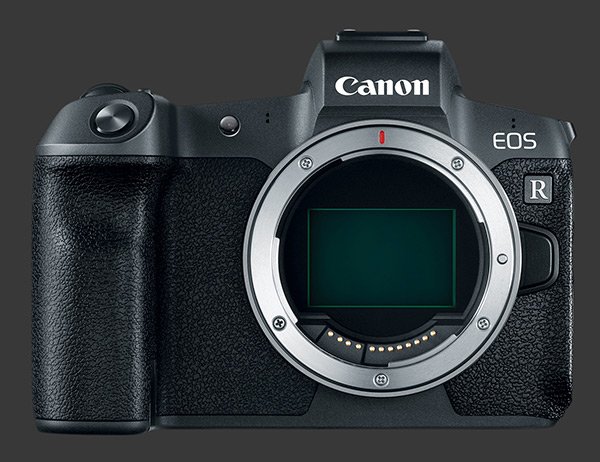
Canon RF Cameras
The Canon RF system is the newest mirrorless platform and has very few cameras. Given that this system is exclusively designed for Full-Frame, every model provides high-end features that includes a built-in EVF with Eye-Start Sensor, at least dual control-dials and a hot-shoe.
Canon leapfrogged everyone when they launched the EOS R5 reviewed here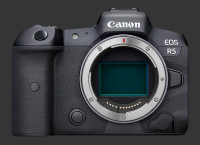
Canon EOS R5 and R6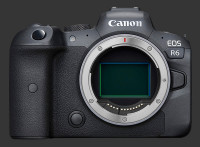
Canon EOS R6 simultaneously. Both these mirrorless cameras feature the most effective image-stabilization with 8-stop of efficiency. Their newly designed weatherproof bodies offer triple control-dials. The difference betweem models comes down to the 45 MP sensor of the R5, compared to a 20 MP in the R6. This allowed the R5 to become the first mirrorless capable of capturing 8K video, although only for a couple of minutes at time before requiring a cooling down period.
Older modes are the EOS R
Canon EOS R, and its nearly identical follow-up for Astrophotography, the EOS Ra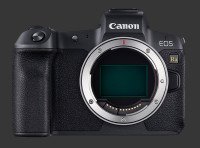
Canon EOS Ra. A semi-advanced EOS RP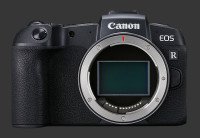
Canon EOS RP followed with slightly lower resolution and a simpler body. None of these have IBIS, putting them at a serious disadvantage.
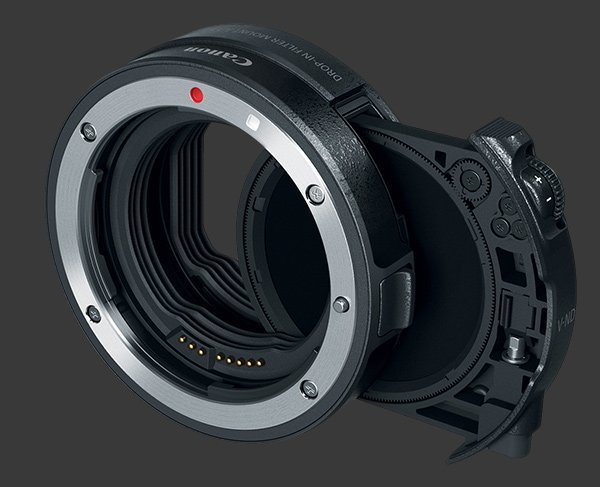
RF-Mount Lenses
In just two years, Canon launched 17 RF-mount lenses, more than the number of EF-M lenses announced in 8 years! They started with a few lenses to demonstrate the capabilities of the new large-diameter mount, including longest F/2 zoom for Full-Frame ever made, the Canon RF 28-70mm F/2L USM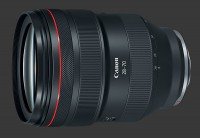
Canon RF 28-70mm F/2L USM.
Canon makes RF-mount lenses covering the 15-800mm focal-range with rectilinear lenses. Nearly every lens offer a bright aperture of at least F/2.8, with the exception of the ultra-zoom Canon RF 24-240mm F/4-6.3 IS USM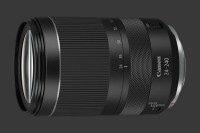
Canon RF 24-240mm F/4-6.3 IS USM and the relatively high-power Canon RF 24-105mm F/4L IS USM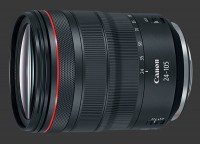
Canon RF 24-105mm F/4L IS USM workhorse. Most lenses in the lineup are constant aperture zooms with a few ultra-bright primes joining in. There are no true macro or other specialty lenses yet. All but two lenses are weatherproof and almost the same number are stabilized.
Third-party manufacturers make a couple of manual lenses now. While none are weatherproof, this adds ultra-wide 12mm coverage and a 2X super-macro lens. Canon ensured compatibility with their extensive lineup of EF lenses for Full-Frame by launching several adapters. These adapters range from simple mount-connection to one which includes a rear polarizer slot, showing that they can use adapters to their advantage.
Canon M
The first attempt from Canon to enter the mirrorless market came from the EF-M mount which is a version of the EF-S mount used their APS-C DSLRs, only with a much shorter flange distance. In theory this makes the mount sufficiently large to support a full-frame sensor, Canon only uses sensors with a 1.6X crop in the Canon M System, leaving Full-Frame to the newer Canon R, described just above.
Canon was considered late to the mirrorless world and the M-system is often seen as one that is trying to catch up. The main reason is that Canon was the most successful camera maker by market share at the time and had cameras of every other type, so there was little incentive to disturb their own market.
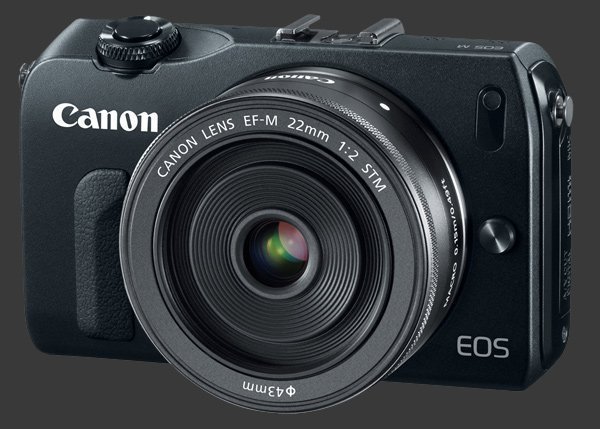
Canon M Cameras
The original EOS M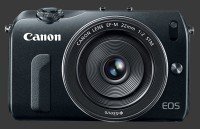
Canon EOS M is a highly compact mirrorless built around the same 18 MP APS-C sensor with 1.6X crop-factor as Canon entry-level DSLRs of the time. It relied on Contrast-Detection AFassisted by on-sensor Phase-Detection sensors. Despite its APS-C sensor, the EOS M is one of the smallest and lightest mirrorless cameras, although it takes on bulk in proportion to the attached lens, as any interchangeable lens camera.
The Canon EOS M family evolved slowly from there. The majority of models in this system are basic entry-level ones. Several of the more recent models include an EVF or support an optional one which greatly helps in terms of usability. Canon splits their lineup by number of digits with single-digit ones being advanced mirrorless. The M6 Mark II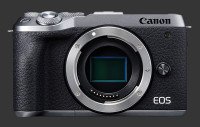
Canon EOS M6 Mark II even offers triple control-dials, although no M-series camera is weatherproof.
Canon shares Dual-Pixel CMOS sensor between the M-system and their 1.6X-Crop APS-C DSLRs. These sensors, which are unique to Canon, can perform can measure light phase at every pixel. All these mirrorless rely on optical image stabilization built into lenses since none of them offers IBIS.
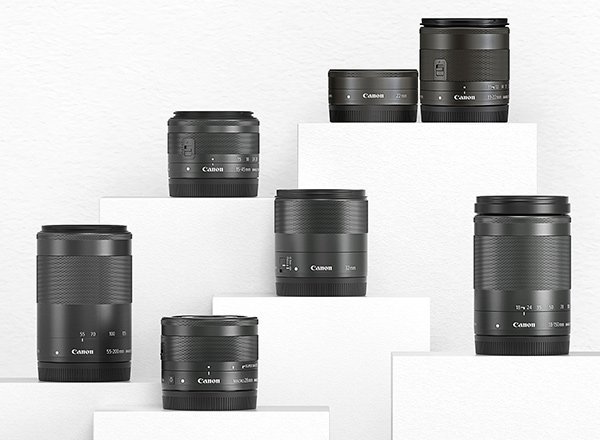
M-Mount Lenses
Canon unveiled exactly two lenses along with the EOS M. Given that they launched in 2012 and that only 9 lenses exist in the Canon EF-M lineup by 2020, there is uncertainty about how much commitment Canon has in the EF-M system. The current lineup spans 11-200mm with only rectilinear lenses, most very compact yet rather dim zoom lenses. Luckily for owners of Canon M cameras, third-party manufacturers produced over 4X more lenses.
The EF-M mount is electronically compatible with EF and EF-S lenses. An adapter allows any Canon DSLR lens to be attached to an EF-M mount camera. Samyang and Tamron have joined as third-party makers of EF-M lenses. The former only offers Manual-Focus lenses, as usual.
Next
Proceed to Step 4, Mirrorless Camera Buying, for advice and considerations before buying a mirrorless.
Please Support Neocamera
All information on Neocamera is provided free of charge yet running this website is a huge endeavor. Purchases made via affiliate links found throughout the site help keep it running and up-to-date. There is no additional cost to you, so please consider buying via these links to our affilates:
If you found any information on this site valuable and did not purchase via our affiliate links, please considering donating via PayPal:
Any amount will be greatly appreaciated. Thank you for your support!
New Cameras & Lenses

Canon RF-S 14-30mm F/4-6.3 IS STM PZ
Stabilization
Canon RF Mount Zoom
2025-03-26
Canon RF 20mm F/1.4L VCM
Weatherproof
Canon RF Mount Prime Lens
2025-03-26
Canon EOS R50 V
24 Megapixels Mirrorless
Canon RF Lens Mount
2025-03-26
Venus Optics Laowa 14mm T/2.6 Zero-D VV Cine
Sony E Mount Prime Lens
2025-03-25
Venus Optics Laowa 14mm T/2.6 Zero-D VV Cine
Nikon Z Mount Prime Lens
2025-03-25
Venus Optics Laowa 14mm T/2.6 Zero-D VV Cine
Leica L Mount Prime Lens
2025-03-25
Updates
2025.01.18

Fujifilm GFX 2025 Lens Roundup
Lens Review roundup of Fujifilm GFX Medium-Format lenses. Quality, performance and handling of the GF20-35mm F/4R WR, GF30mm F/3.5 Tilt-Shift and the GF55mm F/1.7.
2024.11.18

Best 2024 Photography Gifts for Every Budget
Great gifts for photographers and photo enthusiasts selected for every budget among the best products of 2024.
2024.08.07

Eye Protection Tips for Professional Photographers
The four main considerations for professional photographers regarding eyewear.
2024.07.14

Fujifilm X100VI Review
Flagship fixed-lens compact digital camera with a 40 MP sensor and Image-Stabilization, a first for the series. Retro design featuring dual control-dials, plus direct ISO, Shutter-Speed and EC dials. Its hybrid viewfinder can switch between EVF and OVF mode.
2024.05.09

Fujifilm GFX100 II Review
Flagship 102 Megapixels Medium-Format Mirrorless Digital Camera with 8-Stop 5-Axis IBIS, 8 FPS Drive, 8K Video and 400 MP Super-Resolution capture in a weatherproof and freezeproof body with dual control-dials and dual memory-card slots.
2024.04.03

Fujifilm X-T5 Review
Newest Fujifilm flagship boasting a 40 MP APS-C sensor, 5-axis IBIS with 7-stop efficiency, 15 FPS continuous drive, 6.2K Video capture, dual control-dials and dual SDXC UHS-II slots in a sturdy weatherproof and freezeproof body.
2023.11.20

Best Digital Cameras of 2023
Find out which are the Best Digital Cameras of 2023. All the new Mirrorless Digital Cameras from entry-level to high-end professional.
2023.07.10

Fujifilm X-H2 Review
40 Megapixels APS-C Hybrid Mirrorless Digital Camera with 7-stop IBIS. Fastest shutter ever and 8K video capture. Large builtin EVF with 0.8X magnification and 5.8 MP, plus an Eye-Start Sensor. Packed with features and large number of controls in a weatherproof and freezeproof body.
2023.05.07

Sony FE 20-70mm F/4G Review
Review of the unique Sony FE 20-70mm F/4G lens. The optical zoom of this lens spans ultra-wide-angle and medium focal-length coverage, making it one of the most versatile Full-Frame lenses on the market.
2023.01.15

Huion Inspiroy Dial 2 Review
Review of the Huion Inspiroy Dial 2 tablet, a medium sized drawing surface with dual dials and customizable buttons. Connects via USB-C or Bluetooth 5.0 with Windows, Linux and Android support.
2022.12.08

How to Pack for a Photo Trip
Find out how to pack for a travel photography trip, carry your gear safely while meeting airline regulations.
2022.11.13

Best Digital Cameras of 2022
The best digital cameras of 2022. A short list of the most outstanding models in their respective categories. Choose one for yourself or as a gift.








